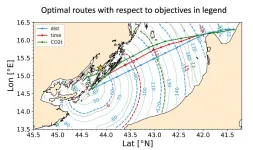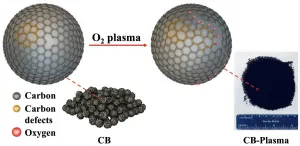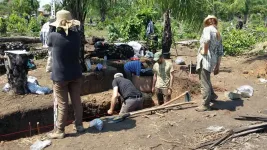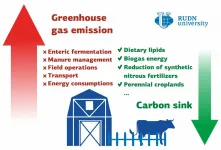(Press-News.org) ALBUQUERQUE, N.M. -- The huge forces generated by the Z machine at Sandia National Laboratories are being used to replicate the gravitational pressures on so-called "super-Earths" to determine which might maintain atmospheres that could support life.
Astronomers believe that super-Earths -- collections of rocks up to eight times larger than Earth -- exist in the millions in our galaxy. "The question before us is whether any of these super planets are actually Earthlike, with active geological processes, atmospheres and magnetic fields," said Sandia physicist Joshua Townsend.
The current work at Z is described in today's Nature Communications. Researchers in Sandia's Fundamental Science Program, working with colleagues at the Earth and Planets Laboratory of the Carnegie Institution for Science in Washington, D.C., use the forces available at Sandia's uniquely powerful Z facility to near-instantly apply the equivalent of huge gravitational pressures to bridgmanite, also known as magnesium-silicate, the most abundant material in solid planets.
The experiments, said Townsend, gave birth to a data-supported table that shows when a planet's interior would be solid, liquid or gaseous under various pressures, temperatures and densities, and in what predicted time spans. Only a liquid core -- with its metals shifting over each other in conditions resembling that of an earthly dynamo -- produces the magnetic fields that can shunt destructive solar winds and cosmic rays away from a planet's atmosphere, allowing life to survive. This critical information about magnetic field strengths produced by the core states of different-sized super-Earths was formerly unavailable: cores are well-hidden by the bulk of the planets surrounding them, and thus not visible by remote viewing. For researchers who preferred earthly experiments rather than long-distance imaging, sufficient pressures weren't available until Z's capabilities were enlisted.
Yingwei Fei, the corresponding author of the current study and senior staff scientist at Carnegie's Earth and Planets Laboratory, is known for his skill in synthesizing large-diameter bridgmanite using multiton presses with sintered diamond anvils.
"Z has provided our collaboration a unique tool that no other technique can match, for us to explore the extreme conditions of super-Earths' interiors," he said. "The machine's unprecedented high-quality data have been critical for advancing our knowledge of super-Earths."
The Magnificent Seven
Further analysis of the state of gaseous and dense materials on specific super-Earths produced a list of seven planets possibly worthy of further study: 55 Cancri e; Kepler 10b, 36b, 80e, and 93b; CoRoT-7b; and HD-219134b.
Sandia manager Christopher Seagle, who with Fei initially proposed these experiments, said, "These planets, which we found most likely to support life, were selected for further study because they have similar ratios to Earth in their iron, silicates and volatile gasses, in addition to interior temperatures conducive to maintaining magnetic fields for protection against solar wind."
The focus on supersized, rather than small, planets came about because large gravitational pressures mean atmospheres are more likely to survive over the long haul, said Townsend.
For example, he said, "Because Mars was smaller, it had a weaker gravitational field to begin with. Then as its core quickly cooled, it lost its magnetic field and its atmosphere was subsequently stripped away."
Z in action
For these experiments, the Z machine, with operating conditions of up to 26 million amps and hundreds of thousands of volts, creates magnetic pulses of enormous power that accelerate credit card-sized pieces of copper and aluminum called flyer-plates. These were propelled much faster than a rifle bullet into samples of bridgmanite, the Earth's most common mineral. The near-instantaneous pressure of the forceful interaction created longitudinal and transverse sound waves in the material that reveal whether the material remains solid or changes to a liquid or gas, said Sandia researcher and paper author Chad McCoy. With these new results, researchers were supplied with solid data on which to anchor otherwise theoretical planetary models.
The technical paper concludes that the high-precision density data and unprecedently high melting temperatures achieved at the Z machine "provide benchmarks for theoretical calculations under extreme conditions."
Concluded Fei, "Our collaboration with Sandia scientists has led to results that will encourage more academic exploration of exoplanets, whose discovery has captured the public imagination."
"This work identifies interesting exoplanet candidates to explore further," said Seagle. "Z shock compression plus Fei's unusual capability to synthesize large-diameter bridgmanite lead to an opportunity to obtain data relevant to exoplanets that would not be possible anywhere else."
INFORMATION:
The work was supported by the National Science Foundation, the Z Fundamental Science Program and a Carnegie Venture grant.
Sandia National Laboratories is a multimission laboratory operated by National Technology and Engineering Solutions of Sandia LLC, a wholly owned subsidiary of Honeywell International Inc., for the U.S. Department of Energy's National Nuclear Security Administration. Sandia Labs has major research and development responsibilities in nuclear deterrence, global security, defense, energy technologies and economic competitiveness, with main facilities in Albuquerque, New Mexico, and Livermore, California.
Sandia news media contact:
Neal Singer,
nsinger@sandia.gov,
505-977-7255
Energy efficiency or carbon intensity (defined as CO2 emissions per transport work, ed.) is a possible point of convergence between the International Maritime Organization (IMO) and EU regulations to cut GHG emissions and decarbonize shipping. Short term measures to increase energy efficiency and achieve carbon intensity savings include voyage optimization.
A new study led by the CMCC Foundation, realized in the framework of the Interreg Italy-Croatia END ...
New research by Morgan Philbin, PhD, at Columbia University Mailman School of Public Health and colleagues looks at why Black young men who have sex with men (YMSM) are disproportionately subject to high rates of arrest and incarceration. They find that perceived racial discrimination, sexual orientation discrimination, and HIV-status discrimination are all associated with risk for criminal justice involvement in this population.
The research appears in the journal Stigma and Health.
Various studies have shown that Black men are imprisoned at nearly seven times the rate of white men; sexual minority young adults are nearly three times more likely to report being criminally sanctioned compared to their heterosexual ...
An electrocardiogram (ECG) is an examination that records the electrical activity of the heart during the cardiac cycle. It is non-invasive and usually involves placing electrodes on the subject's skin. It is a most indicated type of examination when there is suspected heart disease and also in routine preventive health check-ups.
The cardiac cycle entails the emptying of blood from the atria to the ventricles ("P" wave, red in the image), the contraction of the ventricles to propel blood to the different tissues and organs of the body ("QRS" wave, green in the image), and ...
ATLANTA--ProAgio, a drug developed by Georgia State University biology professor Zhi-Ren Liu and his team, is effective at treating pancreatic cancer and prolonging survival in mice, according to a study published in the journal Cellular and Molecular Gastroenterology and Hepatology.
A second study, published in the Journal of Experimental Medicine, shows the drug is also effective against triple-negative breast cancer, a fast-growing and hard-to-treat type of breast cancer that carries a poor prognosis.
ProAgio, created from a human protein, targets the cell surface receptor integrin αVβ?, which is expressed on cancer-associated fibroblasts. Fibroblasts are cells ...
HOUSTON - (Feb. 9, 2021) - Rice University researchers have created a "defective" catalyst that simplifies the generation of hydrogen peroxide from oxygen.
Rice scientists treated metal-free carbon black, the inexpensive, powdered product of petroleum production, with oxygen plasma. The process introduces defects and oxygen-containing groups into the structure of the carbon particles, exposing more surface area for interactions.
When used as a catalyst, the defective particles known as CB-Plasma reduce oxygen to hydrogen peroxide with 100% Faradaic efficiency, a measure of charge transfer in electrochemical reactions. The process shows promise to replace the complex anthraquinone-based production ...
With the COVID-19 pandemic entering its second year, the challenges faced both by individuals and nations remain substantial. While notable medical advancements in the treatment of COVID-19 have been made, a host of questions about how to live with it and how to work to end it remain active.
Carnegie Mellon University researchers David Rode and Paul Fischbeck explore these questions in a new article, "On ambiguity reduction and the role of decision analysis during the pandemic," published in a special issue of the journal END ...
Wintertime outbreaks of COVID-19 have been largely driven by whether people adhere to control measures such as mask wearing and social distancing, according to a study published Feb. 8 in Nature Communications by Princeton University researchers. Climate and population immunity are playing smaller roles during the current pandemic phase of the virus, the researchers found.
The researchers -- working in summer 2020 -- ran simulations of a wintertime coronavirus outbreak in New York City to identify key factors that would allow the virus to proliferate. They found that relaxing control measures in the summer months led to an outbreak in the winter regardless of climate factors.
"Our results implied that lax control measures -- and likely ...
Ancient Amazonian communities fortified valuable land they had spent years making fertile to protect it from conflict, excavations show.
Farmers in Bolivia constructed wooden defences around previously nutrient-poor tropical soils they had enriched over generations to keep them safe during times of social unrest.
These long-term soil management strategies allowed Amazonians to grow nutrient demanding crops, such as maize and manioc and fruiting trees, and this was key to community subsistence. These Amazonian Dark Earths, or Terra Preta, were created through burning, mulching, and the deposition of organic waste.
It was known that some communities built ditches ...
An ecologist from RUDN University suggested a method to evaluate and reduce the effect of animal farms on climate change and developed a set of measures for small farms that provides for the complete elimination of greenhouse gas emissions. The results of the study were published in the Journal of Cleaner Production.
Crop and animal farming and other agricultural activities account for almost a quarter of all greenhouse gases produced by humanity and therefore add a lot to climate change. On the other hand, the soils and biomass accumulate a lot of carbon, thus preventing it from getting into the atmosphere as a part of carbon dioxide and slowing climate change down. An ecologist from RUDN University suggested ...
Ithaca, NY--Love them or hate them, there's no doubt the European Starling is a wildly successful bird. A new study from the Cornell Lab of Ornithology examines this non-native species from the inside out. What exactly happened at the genetic level as the starling population exploded from just 80 birds released in New York City's Central Park in 1890, peaking at an estimated 200 million breeding adults spread all across North America? The study appears in the journal Molecular Ecology.
"The amazing thing about the evolutionary changes among starling populations ...





